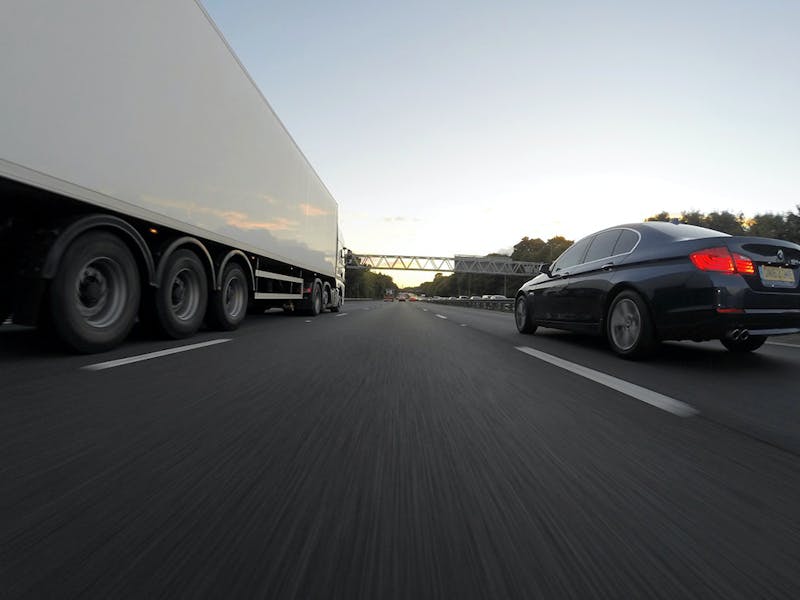
Vehicle accidents of any kind can be traumatic and damaging to everyone involved, physically, emotionally, and financially. Roads can be dangerous, and roads filled with a lot of large trucks like 18-wheelers can be even more dangerous.
As motorists, we’re always paying attention to our surroundings, and we try to drive as safely as possible, but sometimes accidents still happen. If you or someone you know has been in an accident with a semi or other large truck in Little Rock or surrounding areas, you can pursue legal action, and McMath Woods, P.A. can help.
Most Common Types of Semi-Truck Crashes
There are seven common types of large truck accidents, most of which are easily avoidable both by the truck drivers and drivers of other vehicles. Most accidents occur when drivers are distracted, speeding, fatigued, or under the influence of alcohol or drugs. These common accidents are dangerous and deadly for any vehicle, but more so when large trucks are involved:
- T-bone accidents (also called side-impact or broadside crashes): These happen most often in intersections and usually when someone traveling through an intersection runs a red light, ignores stop signs, or somehow violates the proper right of way. This type of wreck with an 18-wheeler can be devastating to smaller cars, especially for those on the side of the car most impacted by the crash.
- Rear-end collisions: Large trucks are heavy and hard to maneuver, especially when it comes to slowing down suddenly if there is traffic congestion or if someone cuts too fast or too close in front of them. Sometimes, it’s the truck driver who is distracted, speeding, under the influence, or tailgating, and their negligence can lead to major injuries or even fatalities in smaller cars when they run into the back of them.
- Head-on collisions: When drivers, of both small cars and big trucks, are reckless, under the influence, or lose control of their vehicles, they can drift into the flow of oncoming traffic and cause horrendous damage. Truck drivers especially are known for driving long hours trying to meet their quotas and may be drowsy behind the wheel.
- Jackknife accidents: This type of accident usually happens when a truck driver applies the brakes too quickly or too hard, especially in inclement weather. It causes the tractor portion, or the cab, of the 18-wheeler to slow down much faster than the trailer portion, which results in a fishtail motion from the trailer. This is unpredictable and can not only create an obstacle for other drivers but can hit other cars and carry them down the highway.
- Truck rollovers: Large trucks like 18-wheelers have a higher center of gravity than smaller cars, which makes it much easier for them to tip and roll over during an accident. Truck drivers have to be careful not to drive too fast around turns or when making sudden swerves or when the road conditions aren’t optimal because it can cause their entire cab and trailer to roll. Overloaded or improperly secured trailers also cause trucks to roll over much more easily.
- Sideswipe accidents: A lot of these accidents between large trucks and smaller cars happen when the truck drivers don’t properly check their blind spots when they’re changing lanes and it can cause the sideswiped car to veer into oncoming traffic. These incidents can also occur when drivers lose control of their vehicles for a myriad of reasons (fatigue, tire blowouts, road obstacles, inclement weather, etc.) and begin to drift into the lanes next to them.
- Wide turn accidents: Trucks like 18-wheelers need much more space to make turns, especially right-hand turns, and often have to veer into oncoming traffic or into the lanes next to them in order to make these turns. Large trucks also have very large blind spots, so if a smaller car tries to squeeze by them during turns, the truck drivers won’t see it, which causes the truck to crash into the smaller car.
Other Drivers Are More Likely To Be Injured or Killed
According to the National Safety Council (NSC), large trucks accounted for 9% of all vehicles involved in fatal accidents in 2021. 5,700 large trucks were involved in a deadly collision, an 18% increase from 2020. And in 2021, 117,300 large trucks were involved in injury-causing crashes, a 12% increase from 2020.
When a semi-truck accident occurs, the percentage of other drivers injured is far greater than that of large truck drivers. Large truck data from the NSC states that, in 2021, other drivers made up 71% of those injured in large truck accidents, compared to the truck occupants at 27.1%.
Additionally, of the 18-wheeler accidents reported in 2021, 71.7% of deaths were the occupants of other vehicles, while only 17.4% of deaths were the occupants of the large trucks. A total of 5,788 people died in large truck crashes.
Safety Tips for Driving Near Trucks
When we drive pretty much anywhere, we’re going to encounter large trucks and 18-wheelers. Here are some great tips to remember when driving near trucks that will help keep everyone safe on the road:
- Never cut off a truck: Large trucks need much more space than a smaller car to safely stop or slow down, plus they might not be able to see you if you cut too close in front of them.
- Don’t tailgate: Riding a truck’s bumper puts you in their blind spot, and you risk sliding under the truck in the event of a crash or if the truck suddenly moves backward.
- Stay visible: Trucks have much bigger blind spots than cars do. If you can’t see the truck driver in their side mirror, chances are likely that they can’t see you, either.
- Anticipate wide turns: Don’t block the box at intersections and realize that trucks need much more room to maneuver than smaller cars do.
- Pass with care: Never attempt to pass a truck on a downgrade or until you can see it in your rearview mirror. Also, if they’re trying to pass you, slow down and give them room.
- Be patient: 18-wheelers take longer to accelerate and slow down than cars do, and you could cause a distraction and subsequent accident if you drive aggressively due to impatience.
Knowing how to drive safely around large trucks, like knowing where their blind spots are and how much space to give them, is not just basic driving safety but can actually save lives in some instances.
You’re Not in This Alone
Dealing with personal injury litigation involving large trucks and 18-wheelers can be confusing and exhausting. While there is no real way to calculate the average amount awarded in large truck settlements, most claimants receive thousands in compensation. Especially if the truck driver is working for a trucking company and when the truck driver has the most percentage of fault in the accident.
There are so many parts to the settlement process, and most people have never experienced it before, this is why hiring an experienced Little Rock truck accident lawyer and following their advice is so important. Contact McMath Woods, P.A today and see how we can help you get the help you need.

